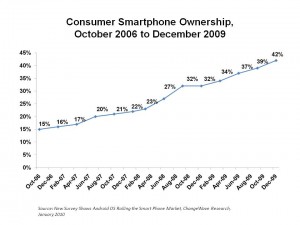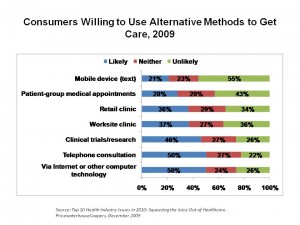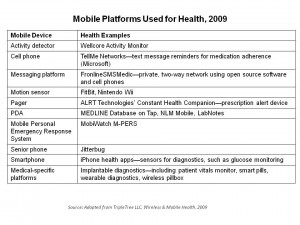As citizens morph into becoming health consumers, they’re adopting DIY tools on the same journey they’ve made into DIY entertainment, DIY financial management, DIY travel, and DIY photo development.
The train’s left the station on DIY health, and mobile phones are one of the main tools in peoples’ armamentaria. Simple text messaging in health has been used for years in developing nations, who have leapfrogged ahead of the U.S. and many other wealthier nations that have a legacy of big-iron medical devices and closed health information systems. SMS is deployed in nations to combat the spread of HIV/AIDS, to remind mothers of well-baby visits and vaccination schedules, to ping people for medication reminders for chronic meds.
The smartphone turbocharges these applications. And many health citizens are empowered by the thousands of apps available in places like the iTunes Store.
I wrote How Smartphones Are Changing Health Care for Consumers and Providers to understand the current state of this phenomenon. The paper was published earlier this month by the California HealthCare Foundation. It discusses the dynamic intersection of personal communications and health, where the smartphone is the sweet spot for a growing number of people — patients, caregivers, doctors, nurses, and healthy folks who simply want to hang on to their health and nurture their wellbeing.
Mobile phones are fairly ubiquitous, and as the first chart illustrates, smartphones are being adopted very quickly. B.J. Fogg, whom I interviewed for the paper, leads the Persuasive Technology Project at Stanford, and co-wrote the seminal book, Texting 4 Health. He wrote in the book that, “In some ways, we don’t merely adopt cell phones. We marry them. We usually spend more time with our mobile phoens than with our spouses or partners…the best interactions in a marriage will create feelings of trust, competence, and delight.”
The point is that the phone has become an extension of ourselves, and something Americans were willing to spend more money on during the recession compared with other purchases for which people penny-pinched. And it’s a trusted channel.
It’s becoming both a health care and wellness channel for a growing number of people, who are feeling very DIY about health — both in terms of staying well through using fitness and nutrition apps that are easy (and even fun) to use, and for tracking chronic conditions like asthma, diabetes, and GI issues.
The second chart illustrates that some Americans are willing to receive health information and care in new kinds of ways beyond face-to-face with a physician. More health citizens are preferring the providers’ traditional “laying hands” on a patient to move to digitized advice in trusted bytes over a trusted, convenient channel. And more third party payers are enabling this to happen by paying for e-mail exchanges between providers and patients, as well as Skype-style consultations between doctor and patient.
The smartphone provides essentially a small, convenient, cost-effective hand-held computer. The apps provide intuitively designed, easy to use interfaces that are self-selected by consumer or provider. The explosion of apps has been particularly aimed at medical students, who can carry around “heavy textbook” information on their 2 ounce phone. For busy ER doctors, apps provide help in streamlining care in overcrowded spaces. For chronically ill people on complex drug regimens, they can be reminded and track their medication consumption and symptoms, reporting them back to providers and caregivers who are concerned about aging parents’ ability to care for themselves.
Health Populi’s Hot Points: Lest we get too gadget-optimist, let’s first remember that smartphones aren’t universally distributed. However, by late 2011, some analysts forecasts that smartphone adoption will overtake feature phone market penetration. There are other limiting factors to growth of smartphones in health, from regulatory issues about how the FDA will view the health-smartphone combo, to privacy and security of personal health information moving from a personal smartphone to a provider’s EHR.
Remember that smartphones are yet one piece of the mobile health puzzle that’s emerging. The third chart illustrates the various flavors of mHealth platforms, from senior phones like the great Jitterbug to mobile personal emergency response systems beyond the “I’m falling and I can’t get up” model. Increasingly, sensors implanted in homes will help people manage conditions and wellbeing in seamless ways.
For now, smartphones are filling a gap for many people who want to empower themselves in health using a trusted, beloved device. The market will continue to change as it’s the confluence of two changing, organic phenomena: personal communications and health technology. Add to the mix the emerging health consumer and the drivers shaping her, and you’ve got a market space that requires vigilant observation. Count on Health Populi to be watching. In the meantime, download the Smartphones and Health paper from the CHCF website. That can be your primer into this fascinating marketspace.







 Thank you, Trey Rawles of @Optum, for including me on
Thank you, Trey Rawles of @Optum, for including me on  I was invited to be a Judge for the upcoming
I was invited to be a Judge for the upcoming  For the past 15 years,
For the past 15 years,